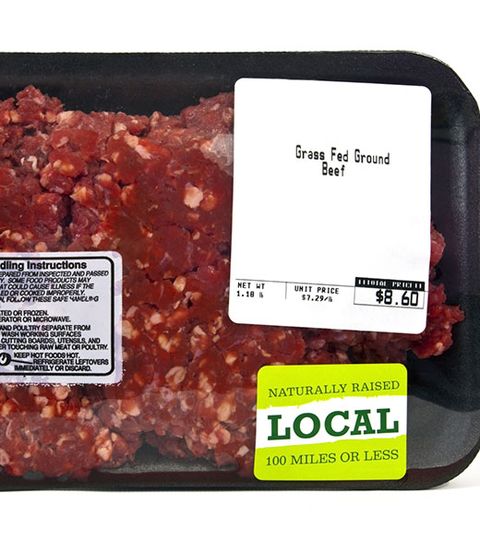Where Can I Buy Grass Fed Bone Broth Near Me

Phillip Britton/Getty Images
Several years ago, grass-fed labels were typically found simply in the meat department of markets. No longer. Hip to what consumers want, companies are now slapping the designation on packaged products sold down nigh every supermarket alley. Take, for case, Annie's Homegrown, which recently launched a line of Organic Grass Fed Shells & Real Aged Cheddar, fabricated with cheese from (can you guess?) grass-fed cows. But what does the characterization actually hateful on packaged goods? Hither, the five most of import things you need to know about foods from cows that swallow only grass.
What does grass-fed actually hateful?
Most cows beginning out the same way: raised after birth on their mother's milk and allowed to roam on a pasture, eating whichever wild plants they find. In one case they become to a certain weight, all the same, conventional farming moves cows to feedlots (otherwise known as CAFOs, or full-bodied animal feeding operations), to fatten on a nutrition of corn and soy feed, which is frequently supplemented by growth hormones and antibiotics. A small percentage of farmers (grass-fed beef makes upwardly less than 3% of total United states sales) continue to feed cattle the animal's traditional found-based diet until fully matured, and that's grass-fed. The simple definition: Grass-fed refers to animals raised 100% eating grass.
Why is grass-fed meliorate than grain-fed?
Grass-fed farming is better for the surround because it requires less energy (corn farming relies heavily on oil-based chemic fertilizers) and promotes biodiversity (deep rooted grasses encourage soil nutrition, while the short roots of corn strip the land of its nutrients). It's also better for the animals themselves: Grass feeding allows cattle out of the confined and typically filthy feedlots and provides them with the diet they're accepted to. The meat produced is too more nutritious and less toxic, equally grass-fed farmers tend to raise their cattle using no growth hormones. What's more, enquiry shows grass-fed meat is higher in cancer-fighting conjugated linoleic acid (CLA), desirable fatty acids similar omega-3s, and nutrients like vitamin D, magnesium, and potassium.
More than: This Is the Future of Your Meat
What is the difference between pasture-raised and grass-fed?
The designation grass-fed applies to grass-eating ruminants (those whose natural nutrition is grass and other establish life). Manufacturers use the term grass-fed typically to describe moo-cow meat and cow's dairy, but the label can also be applied to lamb, caprine animal, and bison products. When information technology comes to poultry and pigs—both omnivorous animals that can't survive on only grass—the correct characterization is pasture-raised or pastured, which refers to both the animal's living weather (free range) and diet (grass, plants, and bugs). Beef and other meats can also be labeled pasture-raised if the animals were immune to roam freely simply fed something other than grass (farmers sometimes add a modest corporeality of grain to the diet, particularly during winter).
So what does that label hateful anyway?
When it comes to food labeling, it's e'er best to wait farther than the sticker on a bundle. The USDA defines grass-fed as a diet of 100% grass, but some take advantage of loopholes referring to the animals confinement (the label stipulates the cattle must be allowed to graze only during the growing season, from the first frost of the season to the last) and winter feeding (hay is allowed, and so a grass-fed cow could be raised on a diet primarily of hay). Although the American Grassfed Association (AGA) has stricter standards, including details almost fauna confinement and employ of hormones, at that place are only 300 farms certified with the AGA in the United States. With pasture-raised, no organization is verifying standards, which means the label is frequently used erroneously. If 100% grass-fed or pastured is important to you, store directly from a subcontract or local grocer who tin share the whole production story.
What grass-fed products are the nearly important?
Not just for meat, grass-fed products are also on the rise, with everything from yogurt to protein powders to leather products now touting the label. What is the most important to shop for? Apparently, grass-fed beefiness is important, but grass-fed and pastured proteins, dairy, and eggs have many of the aforementioned nutritional benefits (including more CLAs, omega-3s, and other nutrients) and ecology pluses. In short, when you lot tin can afford the grass-fed label, yous will be doing your body and the planet the best.
This content is created and maintained by a third party, and imported onto this folio to assistance users provide their electronic mail addresses. You may exist able to find more than information about this and similar content at pianoforte.io
Source: https://www.prevention.com/food-nutrition/healthy-eating/a20439199/grass-fed-meat/



Belum ada Komentar untuk "Where Can I Buy Grass Fed Bone Broth Near Me"
Posting Komentar